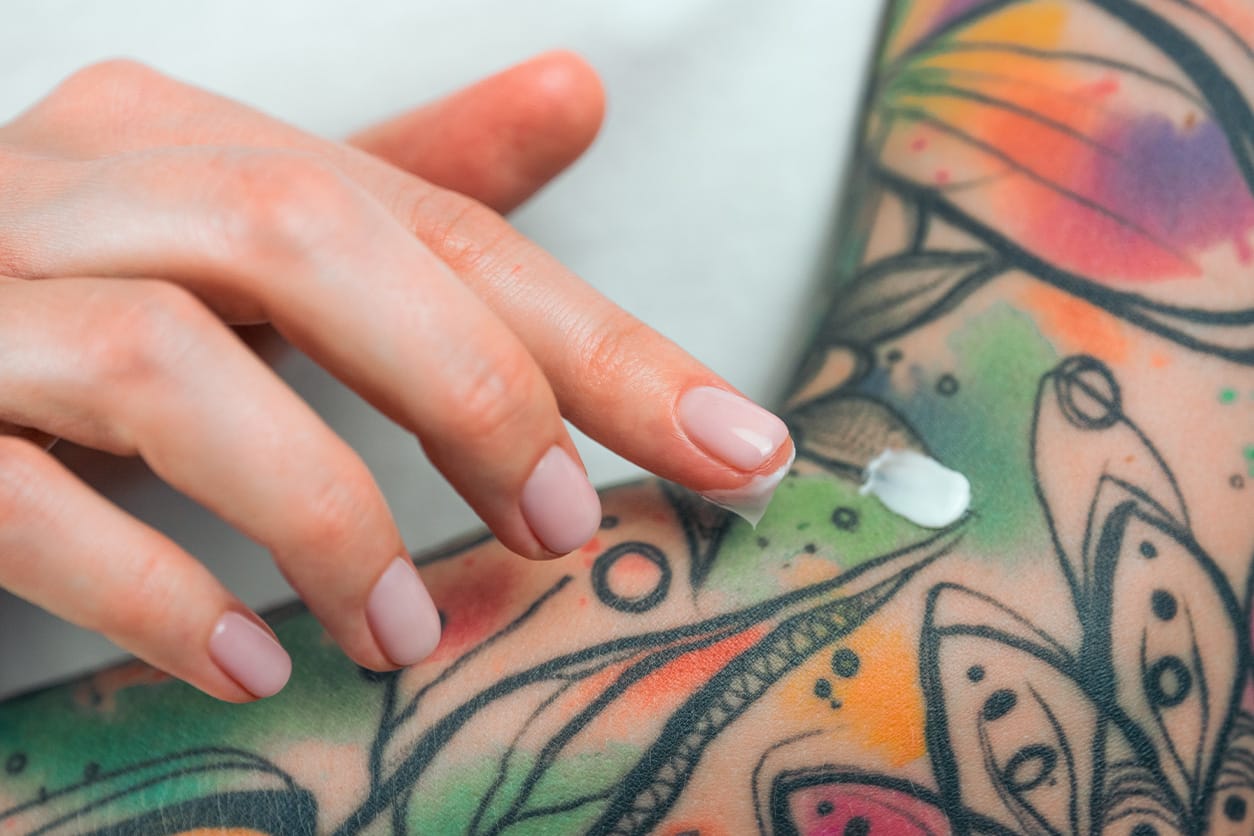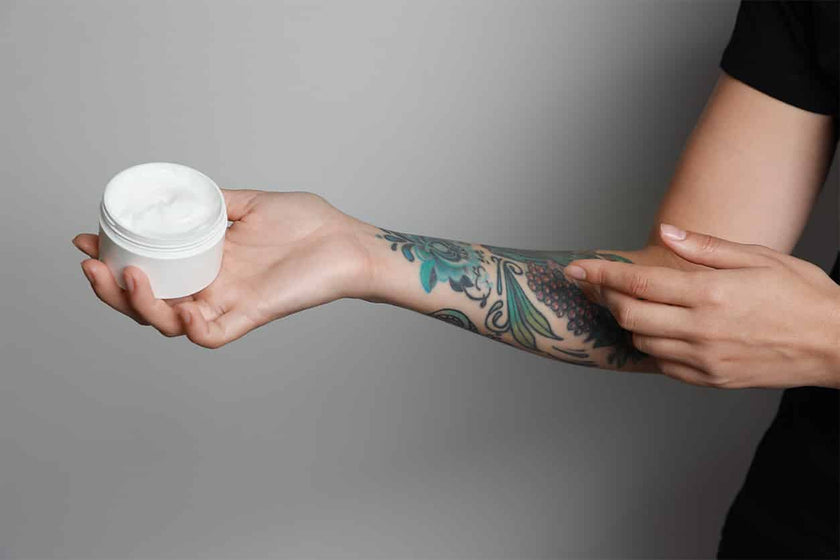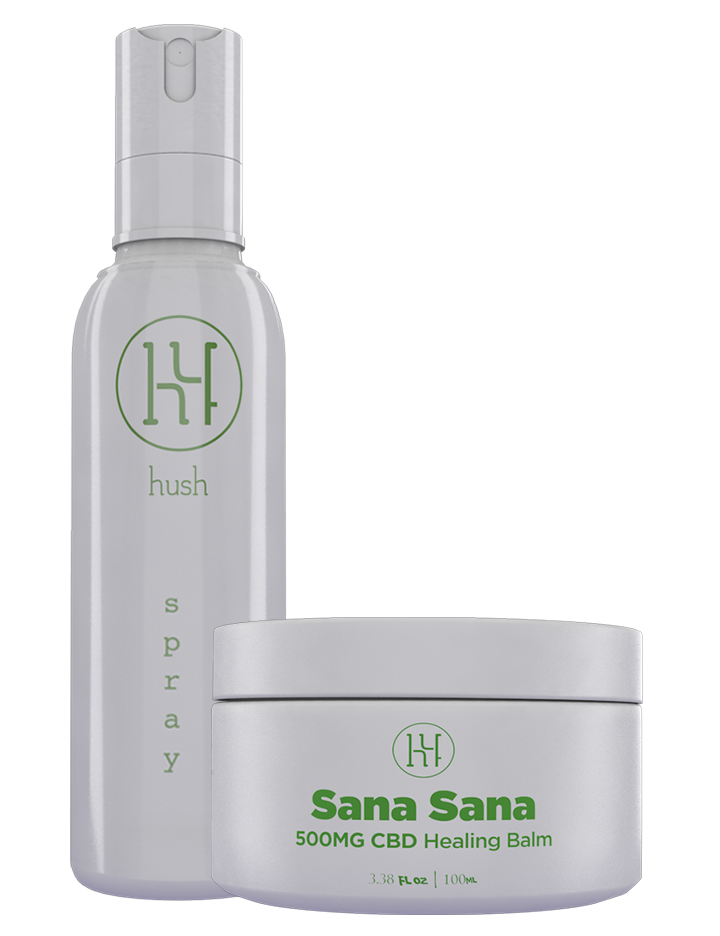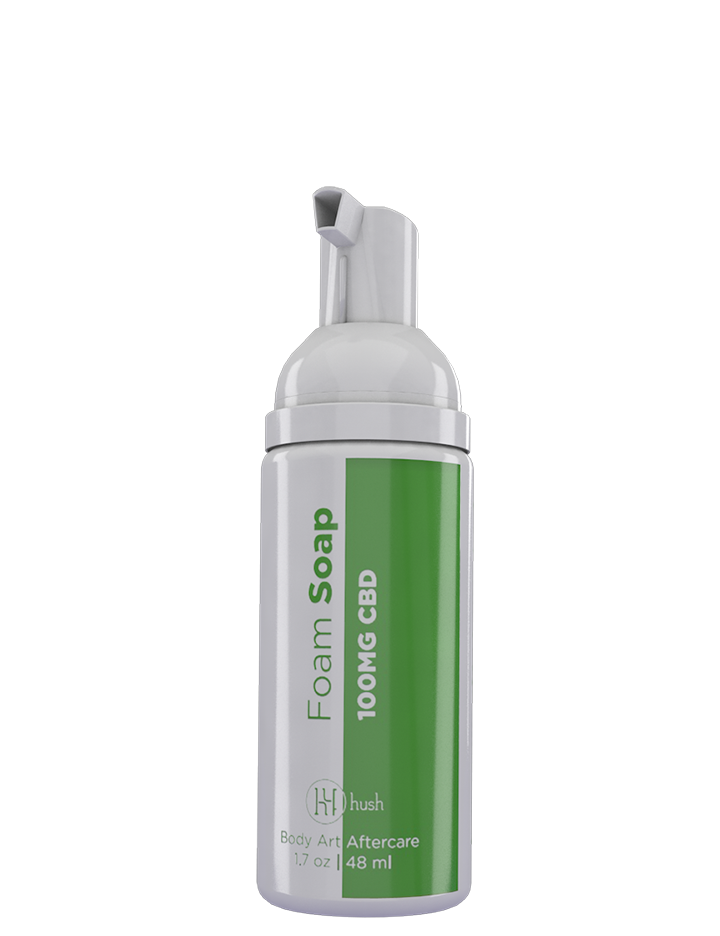
$19.99
Aftercare is a big topic of debate in the tattoo world. How do you best take care of your fresh tattoo? Advice from one professional is disqualified by another professional's opinion. It can be hard to know who to trust. We think the best people to trust are those who have been healing wounds, small and large, for years. Doctors! One of the unanimous aftercare recommendations for a wound is to keep it protected and moisturized. There are several ways to do that, which is where the confusion gets started, but HUSH is here to straighten you out! Today we are talking about keeping your wound protected and moisturized and what Aquaphor has to do with that.
What Is Aquaphor?
Aquaphor is a multi-purpose healing ointment — its packaging states that it can be used on minor wounds and dry skin. For the sake of tattoos being the topic of discussion, we are sticking with Aquaphor’s use on minor wounds, which is what your tattoo is! Aquaphor is made up of 41% petroleum jelly, which lets in some air to help heal the skin, while it also contains panthenol and glycerin, which protect and moisturize the skin. What are these ingredients?
- Petroleum Jelly: Derived from crude oil, petroleum is made by refining the oil until it becomes a topical gel that softens and forms a water-repellant barrier on the skin. It protects bacteria from getting into a wound and keeps moisture from getting out of a wound.
- Panthenol: An alcohol derivative of an acid that is a component of the B complex vitamins. ¿Que? Okay, basically it’s an ingredient that is going to promote positive skin healing reactions on a topical level. Bonus points: It is also a protector, moisturizer, and has anti-inflammatory properties.
- Glycerin: Derived from a chemical reaction of fats, glycerin is that ingredient that you saw being made in Fight Club. You know, the scene where they steal the fat from the hospital and turn it into soap? Yep, glycerin. Glycerin’s magic is that it attracts moisture but doesn’t clog your pores.
What Is Aquaphor Used For?
Aquaphor is used for skin that is dry or cracked, as well as chapped lips. It can also be used for minor cuts and burns as well as other skin irritations. We know the real burners are your questions about using Aquaphor on fresh tattoos. Aquaphor is a pretty common ointment used on fresh tattoos. That’s probably because, next to Vaseline, it’s one of the most popular skincare ointments in general. Aquaphor is most commonly used on tattoos when they are fresh because of its healing properties.
How Well Does Aquaphor Work?
In several wound-healing studies, Aquaphor has performed well if not great. One study that stands out to us though is Aquaphor pitted up against a plant-based, natural ointment. At the end of the study, 90% of the patients preferred the plant-based product to Aquaphor. Aquaphor is pretty good in its own right, but there are other products that people prefer. If you aren’t a petroleum jelly fan, know you have options, including our own natural CBD healing balm, which is made from a blend of all-natural botanicals and cannabinoids — yes, please.
How Much Aquaphor Should You Use on a Tattoo?
Can you use too much Aquaphor? Claro que si, so hold your horses and take your hand off that Aquaphor lid. We know how exciting a new tattoo can be, and constantly loading it up with Aquaphor might make you think it will heal faster, but that just ain’t it. What you actually need to do is use the perfect amount. What is the perfect amount of Aquaphor? A thin covering, enough that your entire tattoo is covered with no gap, but don’t layer it on too thick, or the properties of Aquaphor that allow it to breathe won’t work well. This advisable amount goes for any kind of product you are putting on your tattoo.
How Often Should You Use Aquaphor on a Tattoo?
In the beginning, you should apply ointment whenever your tattoo looks or feels like its current layering of ointment is getting low. Apply after you shower or clean your tattoo.
Does Aquaphor Cause Fading in Tattoos?
There are rumors that Aquaphor makes tattoos fade, but from our experiences and many others, this just isn’t true. If a tattoo is done correctly and the ink is where it needs to be, ointment should only help your tattoo heal correctly. If that’s not the case and your tattoo wasn’t done properly, then that could be the reason it seems like it’s fading. We wrote up a million reasons why it might seem like your tattoo is fading — check your facts here.
Do Other Ointments Work Better Than Aquaphor?
Yes, some ointments work better than Aquaphor for healing your tattoos. Remember that one study we mentioned before about people preferring natural ointment to Aquaphor? People generally like putting more natural things in and on their bodies rather than chemicals, which makes más sense if you ask us. We aren’t trying to scare you. Petroleum jelly is safe to put on your body if it is refined properly and to a high-quality level. You’ll see fear-mongering articles that say differently, but usually, they are talking about if you eat gobs of petroleum jelly or you use petrol on your wounds. So yeah, there are totally other ointments that you can use instead of Aquaphor that are going to heal your tattoo perfectly. In fact, you should check out our CBD healing balm, Sana Sana, which is made from a blend of all-natural botanicals and cannabinoids. You’re getting the benefits of a regular ointment, like Aquaphor, because Sana Sana protects and moisturizes your freshie, AND it also calms skin with its 500 mg of CBD. Sana Sana is also the bomb because it can be used on your healed tattoos to keep them vibrant and help prevent fading.
Are Aquaphor and Vaseline the Same?
Aquaphor and vaseline are different. They are both made with petroleum jelly, but Vaseline is a singular ingredient ointment made of 100% petroleum jelly, and Aquaphor is a multi-ingredient ointment containing 41% petroleum jelly. Don’t use Vaseline on your wounds! Vaseline is not good for wound-healing because it has no breathability. You are suffocating your tattoo — Vaseline traps whatever is in your wound in there. Whether it’s moisture or bad bacteria, what’s in is in! Don’t get it twisted though. Vaseline is safe for the skin, it just needs to be applied with care. Vaseline is better off being used for dry skin around your tattoo once the tattoo has healed. Even then, we are going to recommend a higher caliber moisturizer, like our own Sana Sana, over Vaseline. It does what Vaseline does and more. Aquaphor, on the other hand, is 41% petroleum jelly mixed with other ingredients that help form a barrier that protects the wound and keeps it moisturized. If you are choosing between Aquaphor and Vaseline to put on your tattoo – go with Aquaphor (or just go straight to the good stuff with HUSH’s skincare, duh).
When To Switch From Aquaphor to Lotion?
When you first get a tattoo, you will usually walk out of the shop with your tattoo moisturized with a layer of ointment and a bandage over top. Usually, your artists will explain tattoo aftercare steps to you — telling you to keep that bandage on for 24 hours and then apply a healing ointment after. When is the right time to stop using that ointment and switch over to a regular lotion? You should switch over to a lotion when your tattoo has healed and you are just left with itchy or peeling skin. You won’t need the healing ointment because the deeper wounds have closed and you are just left with some irritated top skin to heal. It typically takes 1 or 2 weeks for your tattoo to heal and be ready for the lotion switchover. It won’t hurt to keep using an ointment for longer than you need to, so don’t stress. Sana Sana is actually a 2-in-1 — you can use it on a fresh tattoo and keep using it after your tattoo has healed! Just make sure, whether you are using an ointment, lotion, or Sana Sana, that you are applying the product in thin layers.
Final Reminders
Aquaphor is a good, cheap option for fresh tattoos, but there are better, more natural, and more powerful options out there, like our own Sana Sana. Make sure you gently cleanse your tattoo before applying protective ointments so you keep the bacteria out and the moisture in (we have antibacterial foam soap for that, too). When you apply that ointment, do so in thin layers. Protect and moisturize, but don’t suffocate your tattoo, and she’ll be healed and ready for showing off in no time. Sources: AquaphorHealing Ointment ® (14oz.) | Aquaphor® Petrolatum, petroleum jelly | Safe Cosmetics Panthenol | C9H19NO4 | PubChem Glycerol | C3H8O3 | PubChem A Comparative Split-Face Trial of Plant-Based Hypoallergenic Ointment vs Petroleum-Based Ointment Following Fractionated Carbon Dioxide Laser Resurfacing of the Face | PubMed A Comparison of Wound Healing Between a Skin Protectant Ointment and a Medical Device Topical Emulsion After Laser Resurfacing of the Perioral Area | PubMed Treatment of Minor Wounds From Dermatologic Procedures | PubMed




